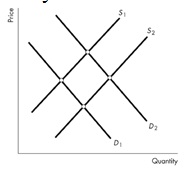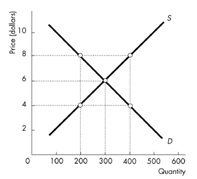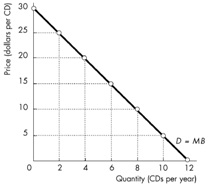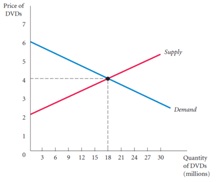Assignment:
Part I. Multiple Choice Question (pick up only one correct answer.)
1. Nick can purchase each milkshake for $2. For the first milkshake purchased Nick is willing to pay $4, for the second milkshake $3, for the third milkshake $2 and for the fourth milkshake $1.
What is the value of Nick's consumer surplus?
A) $2
B) $3
C) $9
D) $10
2. A used car was recently priced at $20,000.00. Seeing the car, Bobby thought, "It's nice, but if I have to pay more than $19,500 for this car, then I would rather do without it." After negotiations, Bobby purchased the car for $19,250.00. His consumer surplus was equal to
A) $19,500.00
B) $1,750.00
C) $250.00
D) $0.00
3. The figure below represents the market for candy. People become more concerned that eating candy causes them to gain weight, which they do not like. As a result, the ____.

A) demand curve shifts from D2 to D1 and the supply curve will not shift.
B) demand curve shifts from D1 to D2 and the supply curve shifts from S1 to S2.
C) demand curve shifts from D2 to D1 and the supply curve shifts from S2 to S1.
D) demand curve will not shift, and the supply curve shifts from S1 to S2.
4. When the quantity demanded equals quantity supplied ____.
A) the government must be intervening in the market.
B) there is a surplus.
C) there is a shortage.
D) None of the above.
5. When the price is below the equilibrium price, the quantity demanded ____
A) is less than the equilibrium quantity. So is the quantity supplied.
B) is less than the equilibrium quantity. The quantity supplied exceeds the equilibrium quantity.
C) exceeds the equilibrium quantity. So does the quantity supplied.
D) exceeds the equilibrium quantity. The quantity supplied is less than the equilibrium quantity.
6. In the figure below, if the price is $8 then ____

A) there is a surplus of 100.
B) there is a surplus of 200.
C) there is a shortage of 100.
D) there is a shortage of 200.
7. The figure above shows Clara's demand for CDs. The market price for a CD is $15. Which statement is true?
A) When Clara buys 6 CDs, she receives $15 of consumer surplus on her 6th CD.
B) When Clara buys 6 CDs, she receives a total of $15 of consumer surplus.
C) When Clara buys 6 CDs, she receives a total of $30 of consumer surplus.
D) When Clara buys 6 CDs, she receives a total of $45 of consumer surplus.
8. In the same figure as above, at a price of $5 for a CD, the value of Clara's total consumer surplus for all the CDs she buys ____.

A) $5.
B) $10.
C) $25.
D) $125.
9. The price elasticity of demand measures ____.
A) how often the price of a good changes.
B) the slope of a budget curve.
C) how sensitive the quantity demanded is to changes in demand.
D) the responsiveness of the quantity demanded to changes in price.
10. If a rightward shift of the supply curve leads to a 6 percent decrease in the price and a 5 percent increase in the quantity demanded, the price elasticity of demand is ____.
A) 0.30.
B) 0.60.
C) 0.83.
D) 1.20.
11. A fall in the price of apple from $10.50 to $9.50 per bushel increases the quantity demanded from 18,800 to 21,200 bushels. Using arc elasticity, the price elasticity of demand is ____.
A) 0.80.
B) 1.20.
C) 1.25.
D) 8.00.
12. The price elasticity of demand for cigarettes is 0.4. If government wants to reduce smoking by 10 percent, by how much should it raise the price of cigarettes ____?
A) By 10 percent.
B) By 20 percent.
C) By 25 percent.
D) By 50 percent.
Part II. Short-Answer Questions
1. The following graph represents the market for DVDs. Find the values of consumer surplus and producer surplus when the market is in equilibrium, and identify these areas on the graph

2. Suppose the market demand for burritos is given by Qd = 40 - 5P and the market supply for burritos is given by Qs = 10P - 20, where P = price (per burrito). What is the equilibrium price and equilibrium quantity? What would happen to total revenue of the seller if the government set the price at $6?